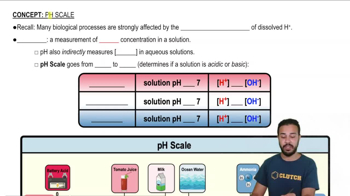Why was finding a close relationship between mitochondrial DNA and bacterial DNA considered particularly strong evidence in favor of the endosymbiosis theory?
Table of contents
- 1. Introduction to Biology2h 42m
- 2. Chemistry3h 40m
- 3. Water1h 26m
- 4. Biomolecules2h 23m
- 5. Cell Components2h 26m
- 6. The Membrane2h 31m
- 7. Energy and Metabolism2h 0m
- 8. Respiration2h 40m
- 9. Photosynthesis2h 49m
- 10. Cell Signaling59m
- 11. Cell Division2h 47m
- 12. Meiosis2h 0m
- 13. Mendelian Genetics4h 44m
- Introduction to Mendel's Experiments7m
- Genotype vs. Phenotype17m
- Punnett Squares13m
- Mendel's Experiments26m
- Mendel's Laws18m
- Monohybrid Crosses19m
- Test Crosses14m
- Dihybrid Crosses20m
- Punnett Square Probability26m
- Incomplete Dominance vs. Codominance20m
- Epistasis7m
- Non-Mendelian Genetics12m
- Pedigrees6m
- Autosomal Inheritance21m
- Sex-Linked Inheritance43m
- X-Inactivation9m
- 14. DNA Synthesis2h 27m
- 15. Gene Expression3h 20m
- 16. Regulation of Expression3h 31m
- Introduction to Regulation of Gene Expression13m
- Prokaryotic Gene Regulation via Operons27m
- The Lac Operon21m
- Glucose's Impact on Lac Operon25m
- The Trp Operon20m
- Review of the Lac Operon & Trp Operon11m
- Introduction to Eukaryotic Gene Regulation9m
- Eukaryotic Chromatin Modifications16m
- Eukaryotic Transcriptional Control22m
- Eukaryotic Post-Transcriptional Regulation28m
- Eukaryotic Post-Translational Regulation13m
- 17. Viruses37m
- 18. Biotechnology2h 58m
- 19. Genomics17m
- 20. Development1h 5m
- 21. Evolution3h 1m
- 22. Evolution of Populations3h 53m
- 23. Speciation1h 37m
- 24. History of Life on Earth2h 6m
- 25. Phylogeny2h 31m
- 26. Prokaryotes4h 59m
- 27. Protists1h 12m
- 28. Plants1h 22m
- 29. Fungi36m
- 30. Overview of Animals34m
- 31. Invertebrates1h 2m
- 32. Vertebrates50m
- 33. Plant Anatomy1h 3m
- 34. Vascular Plant Transport1h 2m
- 35. Soil37m
- 36. Plant Reproduction47m
- 37. Plant Sensation and Response1h 9m
- 38. Animal Form and Function1h 19m
- 39. Digestive System1h 10m
- 40. Circulatory System1h 49m
- 41. Immune System1h 12m
- 42. Osmoregulation and Excretion50m
- 43. Endocrine System1h 4m
- 44. Animal Reproduction1h 2m
- 45. Nervous System1h 55m
- 46. Sensory Systems46m
- 47. Muscle Systems23m
- 48. Ecology3h 11m
- Introduction to Ecology20m
- Biogeography14m
- Earth's Climate Patterns50m
- Introduction to Terrestrial Biomes10m
- Terrestrial Biomes: Near Equator13m
- Terrestrial Biomes: Temperate Regions10m
- Terrestrial Biomes: Northern Regions15m
- Introduction to Aquatic Biomes27m
- Freshwater Aquatic Biomes14m
- Marine Aquatic Biomes13m
- 49. Animal Behavior28m
- 50. Population Ecology3h 41m
- Introduction to Population Ecology28m
- Population Sampling Methods23m
- Life History12m
- Population Demography17m
- Factors Limiting Population Growth14m
- Introduction to Population Growth Models22m
- Linear Population Growth6m
- Exponential Population Growth29m
- Logistic Population Growth32m
- r/K Selection10m
- The Human Population22m
- 51. Community Ecology2h 46m
- Introduction to Community Ecology2m
- Introduction to Community Interactions9m
- Community Interactions: Competition (-/-)38m
- Community Interactions: Exploitation (+/-)23m
- Community Interactions: Mutualism (+/+) & Commensalism (+/0)9m
- Community Structure35m
- Community Dynamics26m
- Geographic Impact on Communities21m
- 52. Ecosystems2h 36m
- 53. Conservation Biology24m
24. History of Life on Earth
History of Life on Earth
Problem 10
Textbook Question
Major divisions in the geologic record are marked by
a. Radioactive dating.
b. Distinct changes in the types of fossilized life.
c. Regular time intervals measured in millions of years.
d. The appearance, in order, of prokaryotes, eukaryotes, protists, animals, plants, and fungi.
 Verified step by step guidance
Verified step by step guidance1
Understand the geologic record: The geologic record is a timeline of Earth's history, divided into eons, eras, periods, and epochs. It is primarily based on evidence from rock layers and fossils.
Recognize the significance of fossils: Fossils provide evidence of past life forms and their evolution. Major divisions in the geologic record often correspond to significant changes in the types of fossilized organisms found in rock layers.
Consider the role of extinction events: Mass extinction events, where many species disappear from the fossil record, often mark transitions between geologic periods or eras. These events are key indicators of major divisions.
Evaluate the options: Analyze each answer choice to determine which best aligns with the concept of major divisions in the geologic record. For example, radioactive dating helps determine the age of rocks but does not directly mark divisions.
Conclude based on fossil evidence: The correct answer is likely related to distinct changes in fossilized life forms, as these changes are the primary markers of major divisions in the geologic record.
 Verified video answer for a similar problem:
Verified video answer for a similar problem:This video solution was recommended by our tutors as helpful for the problem above
Video duration:
1mPlay a video:
Was this helpful?
Key Concepts
Here are the essential concepts you must grasp in order to answer the question correctly.
Geologic Time Scale
The geologic time scale is a system used by geologists and paleontologists to describe the timing and relationships of events in Earth's history. It divides Earth's history into different intervals, such as eons, eras, periods, and epochs, based on significant geological and biological events, including mass extinctions and the emergence of new life forms.
Recommended video:
Guided course

pH Scale
Fossil Record
The fossil record is the collection of all known fossils and their placement in the geologic time scale. It provides crucial evidence of the types of organisms that existed at different times, their evolution, and the environmental conditions of the Earth. Distinct changes in the fossil record often mark major transitions in Earth's biological history.
Recommended video:

Biases in the Fossil Record
Evolutionary Milestones
Evolutionary milestones refer to significant events in the history of life on Earth, such as the appearance of prokaryotes, eukaryotes, and multicellular organisms. These milestones are often associated with major changes in biodiversity and ecosystem structure, and they help to delineate the major divisions in the geologic record, reflecting the progression of life forms over time.
Recommended video:

History of Evolutionary Theory Example 1
Related Videos
Related Practice
Textbook Question
1614
views


